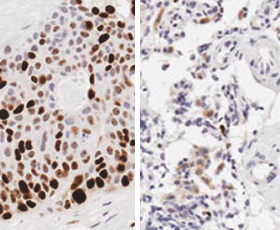Potential pancreatic cancer treatment could increase life expectancy

Pancreatic cancer cells are notorious for being protected by a fortress of tissue, making it difficult to deliver drugs to either shrink the tumor or stop its growth. Now researchers at the University of North Carolina at Chapel Hill have developed a device that could change all that: By using electric fields, the device can drive chemotherapy drugs directly into tumor tissue, preventing their growth and in some cases, shrinking them.
The work, to be published Feb. 4 in Science Translational Medicine, opens the possibility of dramatically increasing the number of people who are eligible for life-saving surgeries. It represents a fundamentally new treatment approach for pancreatic cancer, which has a 75 percent mortality rate within a year of diagnosis - a statistic that has not changed in more than 40 years.
"Surgery to remove a tumor currently provides the best chance to cure pancreatic cancer," said DeSimone who is Chancellor's Eminent Professor of Chemistry at UNC and William R. Kenan, Jr. Distinguished Professor of Chemical Engineering at NC State University. "However, often a diagnosis comes too late for a patient to be eligible for surgery due to the tendency of the tumors to become intertwined with major organs and blood vessels."
"Once this goes to clinical trials, it could shift the paradigm for pancreatic cancer treatments - or any other solid tumors where standard IV chemotherapy drugs are hard to get to," said Jen Jen Yeh, associate professor of surgery and pharmacology in UNC's School of Medicine and a member of the Lineberger Comprehensive Cancer Center.
James Byrne, a member of DeSimone's lab at UNC-Chapel Hill, led the research by constructing the device and examining its ability to deliver chemotherapeutic drugs effectively to pancreatic cancer tumors, as well as two types of breast cancer tumors.

Depending on the tumor type, the new device can be used either internally after a minimally invasive surgery to implant the device's electrodes directly on a tumor (an approach relevant especially for pancreatic cancer and other less accessible tumors) or externally to deliver drugs through the skin (an approach relevant especially for treating inflammatory breast cancers and other accessible tumors such as head and neck cancers).
Researchers have also demonstrated the device's ability to enable higher drug concentrations in tumor tissue while avoiding increased systemic toxicity. This is especially important in treating pancreatic and other solid tumors, which are not well vascularized and are thus difficult to reach using standard treatment methods that rely on the bloodstream for delivering cancer-fighting drugs to tumors.
"Progress in the treatment of pancreatic cancer has been persistent but incremental in the past few decades, relying largely on advances in drug therapies. To our knowledge, our study represents the first time iontophoresis has been applied to target pancreatic cancer," said Byrne, who is currently completing his medical degree at UNC-Chapel Hill after earning his doctorate in 2014 as a member of the DeSimone lab.
"We hope our invention can be used in humans in the coming years and result in a notable increase in life expectancy and quality among patients diagnosed with pancreatic and other types of cancer," added Byrne.
More information: Local iontophoretic administration of cytotoxic therapies to solid tumors, Science Translational Medicine, stm.sciencemag.org/lookup/doi/ … scitranslmed.3009951
















